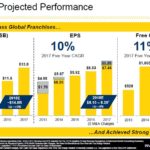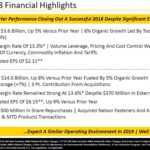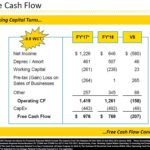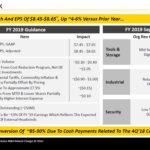Contents
SWK has indicated it is extremely well positioned to hit its $22B revenue target by 2022; FY2018 revenue was just shy of $14B.
SWK has been in business for 175+ years and has successful adapted to challenging political and economic conditions.
Summary
- SWK reported Q4 and FY2018 results on January 22 which were not well received by the investment community.
- SWK has navigated its way through several challenging political and economic environments in its 175+ year history.
- SWK is profitable, generates strong Free Cash Flow and is shareholder friendly thus giving me confidence that management will deploy earnings in the most effective manner possible.
- Opportunities to acquire SWK shares at the current attractive valuation do not present themselves all that often.
Introduction
In my recent If It Looks Too Good To Be True It Probably Is article I expressed concern about investment recommendations being made on a widely followed website. Following that article I notice further higher risk companies have been recommended; I highly suspect some readers will look solely at the dividend yield and will pay little heed to the following:
- Shares are thinly traded with some having an average daily volume of under 50,000 shares/units (fewer than 5,000 shares traded hands on January 22 for one particular recommended company);
- Market cap is typically under $1B with one recently recommended company having a market cap of under CDN $173 million;
- Dividend yields are in the high single or low double digit range. Upon closer analysis some of the dividends consist of a return of capital;
- Minimal growth in the dividend. In some cases there has been no growth in the dividend over a period of years;
- Several of the recommended companies have negligible Free Cash Flow.
I fully recognize we have our own goals and objectives and risk tolerance but I suspect many investors who act on these recommendations do not truly understand the risk they are assuming by investing in these companies.
I am of the opinion that investors should be dialing back risk and a similar sentiment is expressed by Ray Dalio.
Even Stanley Black & Decker’s (SWK) CEO commented on the January 22nd analyst call that:
‘As we enter 2019, the external challenges don’t magically disappear. However, we are well-prepared and positioned to tackle them. In addition, there are signs that the global economic growth is slowing and that the U.S. economy may soon be coming to the end of one of the most enduring recoveries in U.S. history.’
In addition to dialing back risk, I suggest investors focus on investing in companies (such as SWK) that have the wherewithal to adapt to changes in business conditions.
In SWK’s January 22 conference call with analysts, SWK’s President and CEO indicated:
‘As many of you know, in 2018, we faced an unusual and sudden onslaught of large and volatile external headwinds, most of which developed during the course of the year, specifically pressure from input cost inflation, FX and tariffs had, by fourth quarter, grown from our initial January guidance of $150 million pretax to $370 million, which at the EPS level, would have been about 25% dilutive to prior year EPS had we not managed to offset all but $50 million of that with additional price/cost management and other actions. The fact that we ended up delivering 9% adjusted EPS growth in 2018 on 8% revenue growth, which included 5% organic, is quite remarkable. It speaks volumes as to how agile experience – agile our experienced management team deals with short-term adversity and operating environment challenges while continuing to pursue above-market growth and moving the company forward strategically.’
SWK appeals to me because in its 175+ years of business it has experienced a host of economic and political challenges. Although the pace of technological change occurring today is unprecedented, SWK has the resources to adapt.
Insider Activity
I recently wrote an article in which I viewed the comment from a particular company’s CEO as having been somewhat misleading. In my opinion, most retail investors would view the recent 1 million+ share purchase by the two most senior executives of the company as being a huge vote of confidence. When I delved into the recent ‘insider’ transactions, I found these purchases were the exercise of stock options with a conversion price of $11.85/share. Meanwhile, investors would need to purchase shares on the open market at ~$160! Needless to say, I wasn’t impressed.
In the case of SWK, I see that between September 2018 and the end of December 2018 there was a flurry of insider activity as several Senior Executive Officers and Directors received shares as part of the ‘Option Awards’ component of their remuneration. The conversion price linked to the vast majority of these options is in excess of SWK’s current share price.
I fully recognize these insiders did not have to ‘shell out’ from their pockets to acquire these shares. Keep in mind that the shares they received, however, were a component of their compensation. Had they not received ‘Option Awards’, the ‘Cash’ component of their remuneration would likely have been higher so, in effect, the insiders who received shares at a ~$130 conversion price are not really further ahead than the average retail investor who can currently acquire SWK shares at ~$116.
Q4 and FY2018 Results
SWK’s Q4 and FY2018 earnings release can be accessed here and its earnings presentation can be accessed here.
The all important Free Cash Flow (FCF) for FY2018 was ~$0.207B lower than that reported in FY2017 but let’s not lose sight that SWK still generated $0.769B of FCF in a difficult business environment. In addition, despite the impacts of currency, commodity inflation, and tariffs, SWK:
- increased revenue by just over $1B from FY2017;
- experienced only a ~130 bps decline in operating margin (a ~50 bps decline when you exclude M&A related & other charges and a non-cash fair value adjustment);
- completed ~$0.5B in share repurchases.
Source: SWK – Investor Presentation October 31 2018
Source: SWK- Q4 and FY2018 Earnings Presentation – January 22 2019
2019 Outlook
SWK’s share price has taken a pounding because its FY2019 Outlook falls short of analyst expectations.
Source: SWK- Q4 and FY2018 Earnings Presentation – January 22 2019
On SWK’s January 22 conference call with analysts, SWK’s CEO indicated that SWK is still targeting $22B of revenue by 2022; FY2018 revenue was just under $14B.
SWK is of the opinion it is extremely well positioned to hit this $22B target. Its near-term emphasis has, therefore, been shifted from identifying and acquiring new growth catalysts to:
- continuing to execute the catalysts SWK already has;
- focusing on margin rate accretion.
The plan is to leverage the $0.25B cost-reduction program, which is substantially complete, as well as pricing and productivity benefits in 2019.
SWK is also in the process of applying modern technology and advanced analytics to develop and execute a variety of margin expansion initiatives. These initiatives are expected to generate future margin accretion and buffer SWK’s earnings and cash flow from the vagaries of economic cycles and the external operating environment. Additional details on this front are to be provided at SWK’s investor meeting in May.
SWK will also continue to redirect its capital allocation in the short-term to a deleveraging posture. This is expected to provide SWK with flexibility for opportunistic repurchases and for acquisitions and is in keeping with the long-term capital allocation strategy of returning 50% to shareholders and reinvesting 50% into the business.
Credit Ratings
SWK’s senior unsecured debt has been rated ‘Baa1’ by Moody’s since March 15, 2010. S&P Global’s ‘A’ rating has held steady since it was assigned in mid December 2010.
The Moody’s rating is the top tier of the lower medium grade category and S&P Global’s rating is the middle tier of the upper medium grade category.
Regardless of which ratings agency is more accurate, it does not make a difference from my perspective as I view both ratings as acceptable.
Valuation
With FY2019 projected Diluted GAAP EPS of $7.45 – $7.65 and Adjusted Diluted EPS of $8.45 – $8.65 and the share price hovering around $116, I view SWK’s ~15.36 projected PE and ~13.57 projected adjusted PE as being attractive.
Furthermore, when I compare the valuation based on FY2019 projected earnings versus SWK’s valuation of recent years (FY2009 – FY2017) 18.3, 50.8, 17.14, 27.4, 22.4, 22.2, 19.3, 17.4, 21.5, and 18.4 I am of the opinion that SWK is currently reasonably valued.
SWK’s Long Term Capital Allocation Strategy is reflected below.
SWK’s dividend history can be found here.
I fully anticipate SWK’s 4th $0.66 quarterly dividend to be paid in mid June and am of the opinion SWK will increase its quarterly dividend by $0.03 to $0.69 commencing with the September 2019 dividend payment.
Using my dividend projection I anticipate that the next 4 dividend payments will total ~$2.70 thus giving us a forward dividend yield of ~2.32% on the basis of the current ~$116 share price; the dividend yield is just under 2% if you are a Canadian resident and shares are held in a non-registered account.
Although the dividend yield is low, SWK’s dividend growth consistency and relative safety appeal to me. I am also of the opinion that SWK’s shares will appreciate in value of the long-term.
Using SWK’s projected Diluted GAAP EPS of $7.45 – $7.65 and projected Adjusted Diluted APS of $8.45 – $8.65, we see that the next 4 quarters of dividend payments ($2.70) should be within SWK’s target dividend payout ratio range of 30 – 35%.
As at the end of FY2011, SWK had 170,105,000 in weighted average diluted shares outstanding. Fast forward to the end of FY2018 and this has been reduced to 151,643,000. I leave it to management to decide on how best to deploy earnings/free cash flow and am confident the continued reduction in share count can be expected.
Final Thoughts
I began this article expressing concern about some of the companies in which some investors are prepared to invest. In my opinion, this does not seem to be an opportune time to take on undue risk.
In my opinion, SWK certainly faces headwinds but after having been in business through just about every economic environment you can think of during its 175+ years of being in business, I am reasonably confident SWK will be able to navigate its way through the next series of challenges it will likely face over the next few years.
I should have acquired additional SWK shares for the ‘Side Accounts’ within the FFJ Portfolio when the share price pulled back substantially at the end of October 2018 and just before Christmas 2018. I, however, elected to deploy funds to acquire shares in other companies.
Given my outlook on SWK, I view the share price plunge from a ‘glass half full’ perspective and have acquired another 150 SWK shares for the ‘Side Accounts’ within the FFJ Portfolio.
I wish you much success on your journey to financial freedom.
Thanks for reading!
Note: I sincerely appreciate the time you took to read this article. Please send any feedback, corrections, or questions to charles@financialfreedomisajourney.com.
Disclaimer: I have no knowledge of your individual circumstances and am not providing individualized advice or recommendations. I encourage you not to make any investment decision without conducting your own research and due diligence. You should also consult your financial advisor about your specific situation.
Disclosure: I am long SWK.
I wrote this article myself and it expresses my own opinions. I am not receiving compensation for it and have no business relationship with any company whose stock is mentioned in this article.







